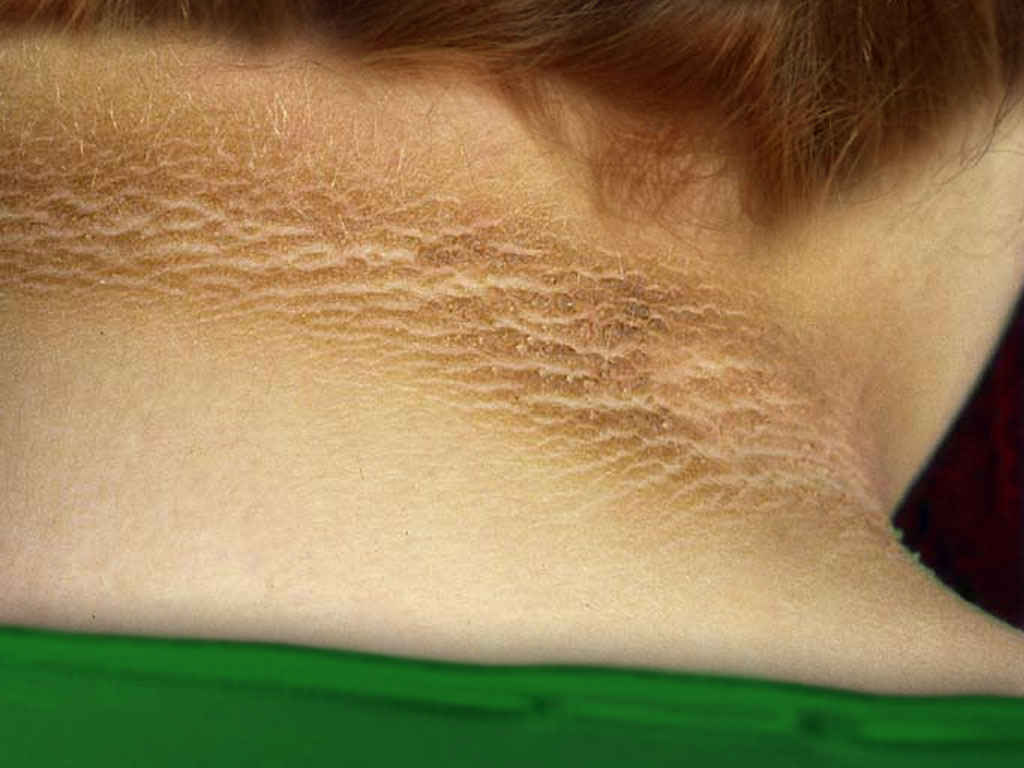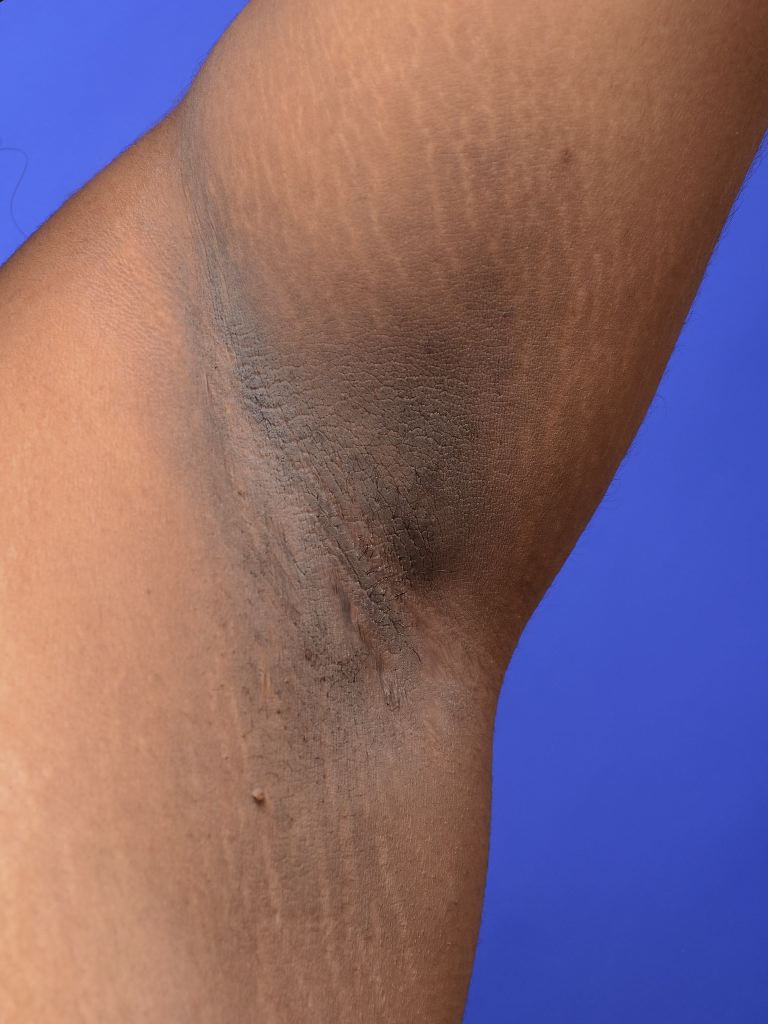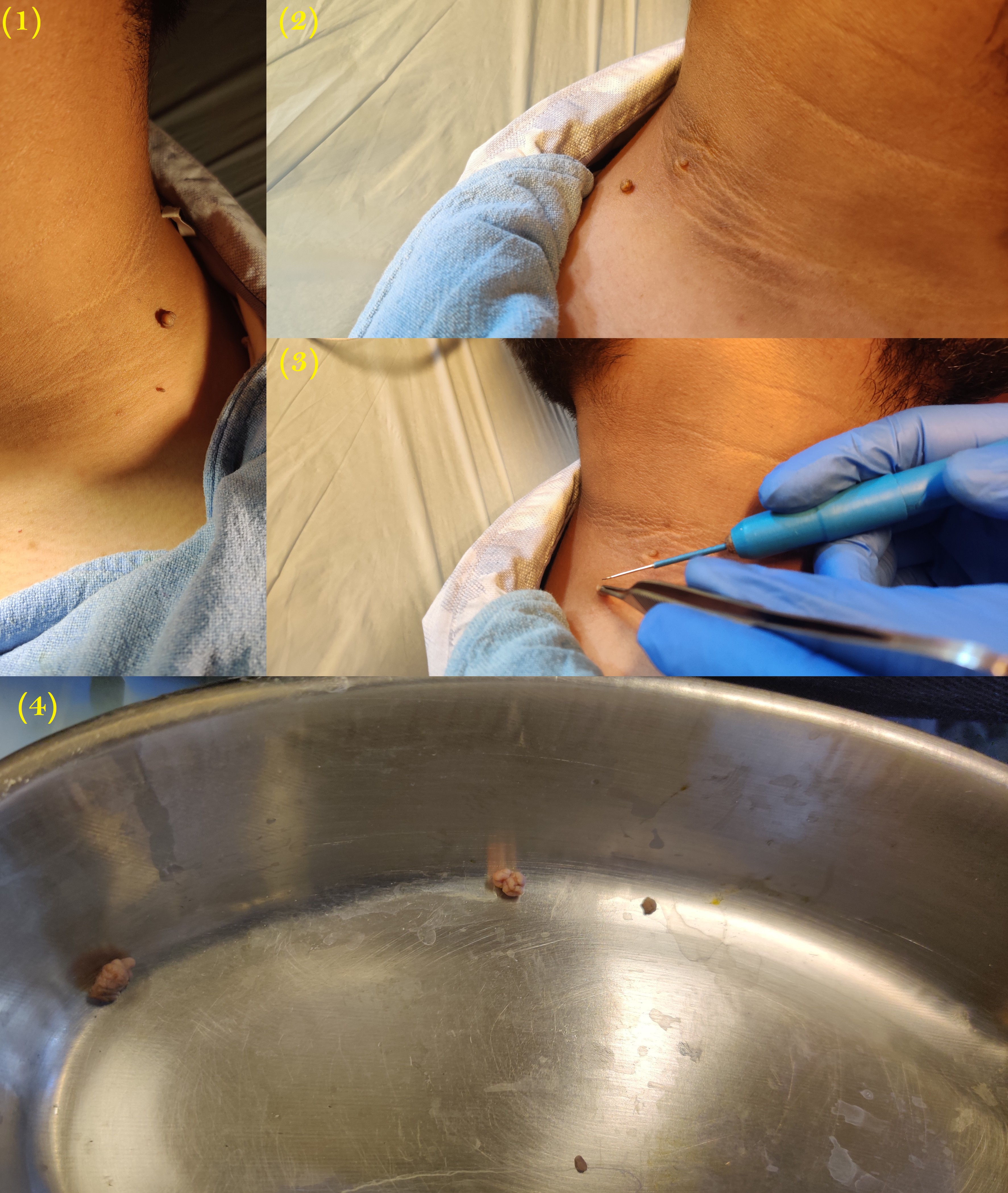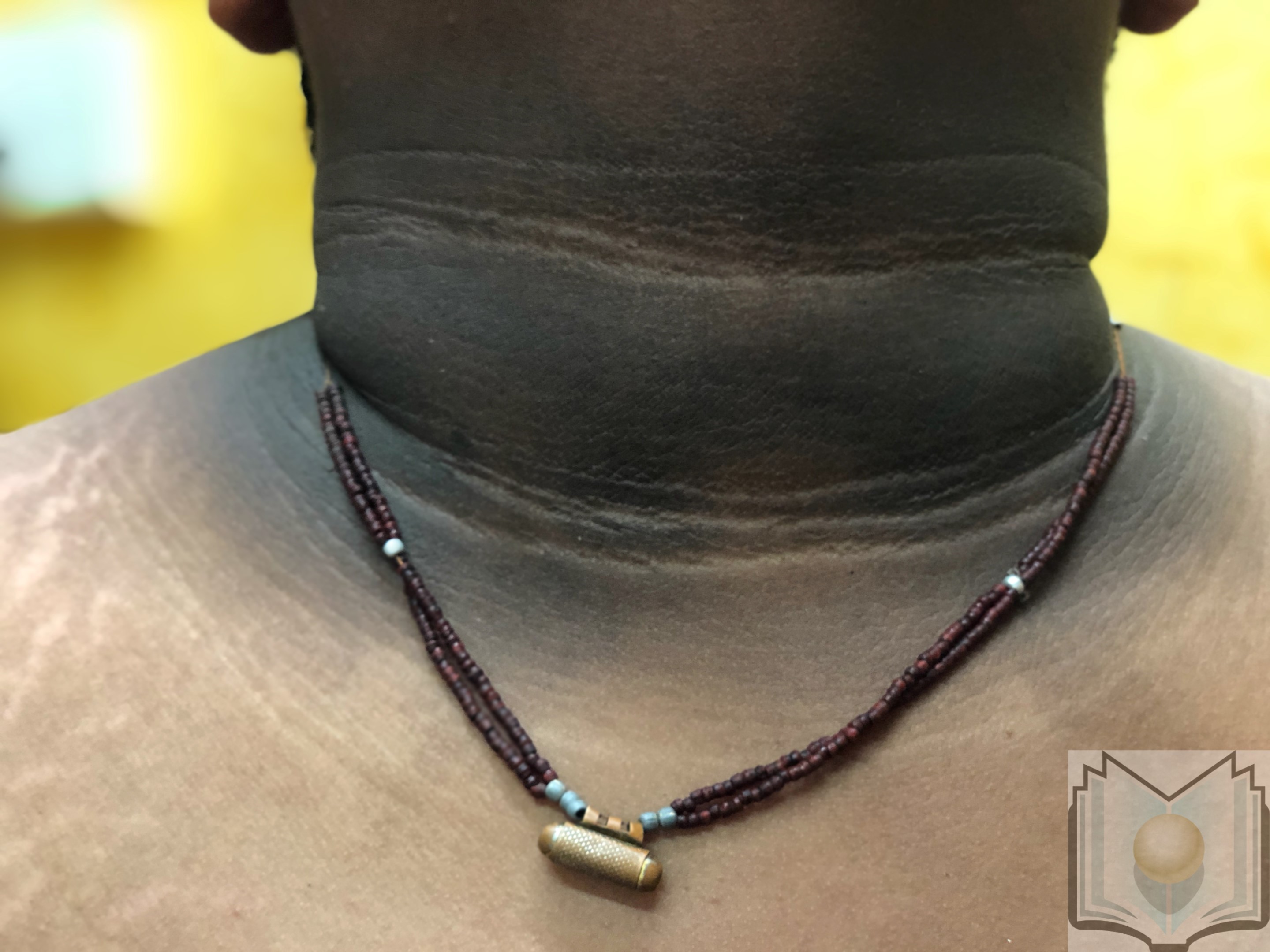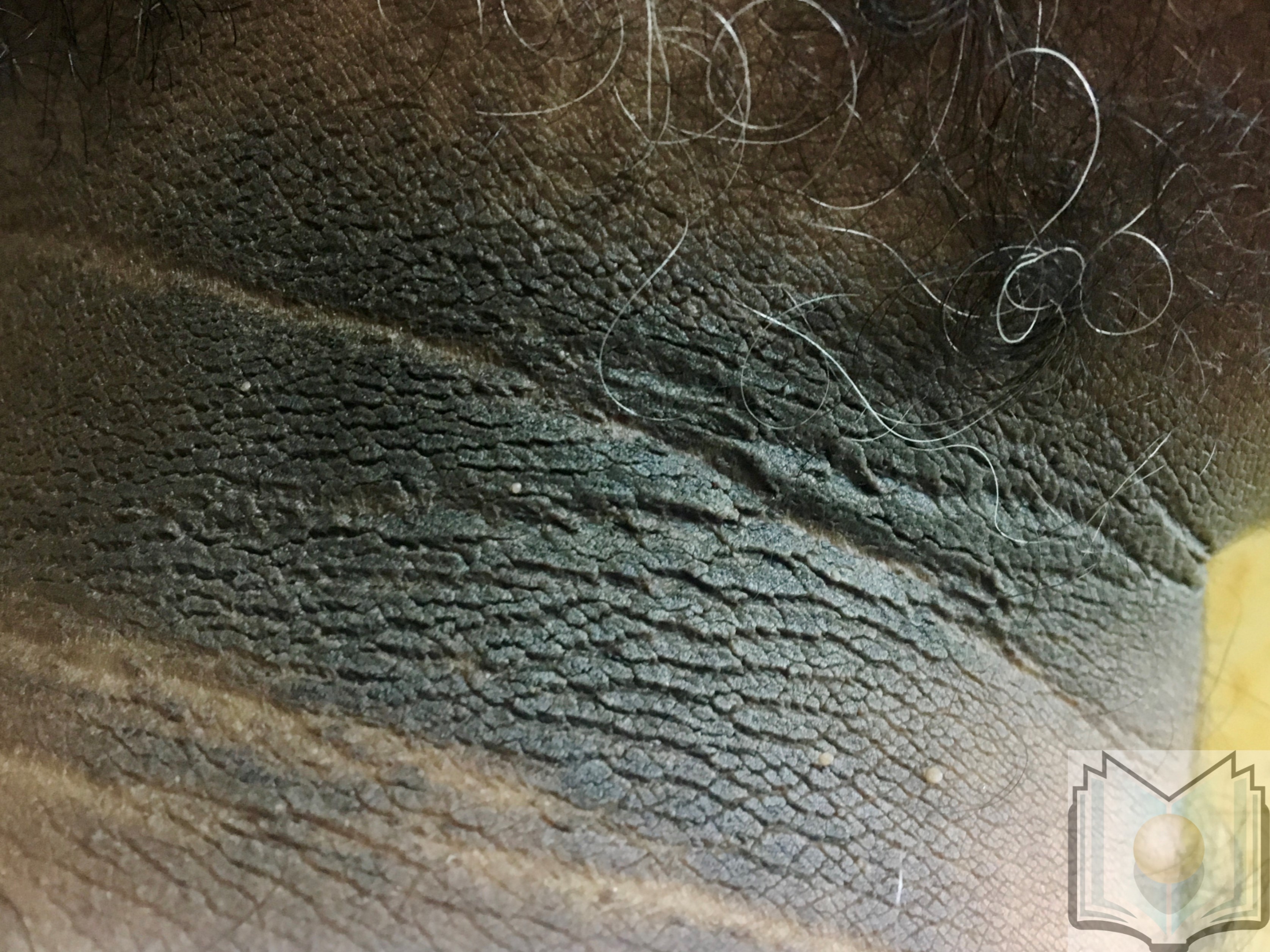[1]
Smid CJ, Modaff P, Alade A, Legare JM, Pauli RM. Acanthosis nigricans in achondroplasia. American journal of medical genetics. Part A. 2018 Dec:176(12):2630-2636. doi: 10.1002/ajmg.a.40506. Epub 2018 Oct 31
[PubMed PMID: 30380187]
[2]
Ozlu E, Uzuncakmak TK, Takır M, Akdeniz N, Karadag AS. Comparison of cutaneous manifestations in diabetic and nondiabetic obese patients: A prospective, controlled study. Northern clinics of Istanbul. 2018:5(2):114-119. doi: 10.14744/nci.2017.68553. Epub 2018 May 21
[PubMed PMID: 30374476]
[3]
González-Saldivar G, Rodríguez-Gutiérrez R, Treviño-Alvarez AM, Gómez-Flores M, Montes-Villarreal J, Álvarez-Villalobos NA, Elizondo-Plazas A, Salcido-Montenegro A, Ocampo-Candiani J, González-González JG. Acanthosis nigricans in the knuckles: An early, accessible, straightforward, and sensitive clinical tool to predict insulin resistance. Dermato-endocrinology. 2018:10(1):e1471958. doi: 10.1080/19381980.2018.1471958. Epub 2018 May 21
[PubMed PMID: 30279953]
[4]
Hermanns-Lê T, Scheen A, Piérard GE. Acanthosis nigricans associated with insulin resistance : pathophysiology and management. American journal of clinical dermatology. 2004:5(3):199-203
[PubMed PMID: 15186199]
[5]
Fukuchi K, Tatsuno K, Matsushita K, Kubo A, Ito T, Tokura Y. Familial acanthosis nigricans with p.K650T FGFR3 mutation. The Journal of dermatology. 2018 Feb:45(2):207-210. doi: 10.1111/1346-8138.14107. Epub 2017 Oct 25
[PubMed PMID: 29068064]
[6]
Ng HY. Acanthosis nigricans in obese adolescents: prevalence, impact, and management challenges. Adolescent health, medicine and therapeutics. 2017:8():1-10. doi: 10.2147/AHMT.S103396. Epub 2016 Dec 16
[PubMed PMID: 28031729]
[7]
Kuroki R, Sadamoto Y, Imamura M, Abe Y, Higuchi K, Kato K, Koga T, Furue M. Acanthosis nigricans with severe obesity, insulin resistance and hypothyroidism: improvement by diet control. Dermatology (Basel, Switzerland). 1999:198(2):164-6
[PubMed PMID: 10325466]
[8]
Stals H, Vercammen C, Peeters C, Morren MA. Acanthosis nigricans caused by nicotinic acid: case report and review of the literature. Dermatology (Basel, Switzerland). 1994:189(2):203-6
[PubMed PMID: 8075456]
Level 3 (low-level) evidence
[9]
Mellor-Pita S, Yebra-Bango M, Alfaro-Martínez J, Suárez E. Acanthosis nigricans: a new manifestation of insulin resistance in patients receiving treatment with protease inhibitors. Clinical infectious diseases : an official publication of the Infectious Diseases Society of America. 2002 Mar 1:34(5):716-7
[PubMed PMID: 11823959]
[10]
Fleming MG, Simon SI. Cutaneous insulin reaction resembling acanthosis nigricans. Archives of dermatology. 1986 Sep:122(9):1054-6
[PubMed PMID: 3527077]
[11]
Schmidt TH, Khanijow K, Cedars MI, Huddleston H, Pasch L, Wang ET, Lee J, Zane LT, Shinkai K. Cutaneous Findings and Systemic Associations in Women With Polycystic Ovary Syndrome. JAMA dermatology. 2016 Apr:152(4):391-8. doi: 10.1001/jamadermatol.2015.4498. Epub
[PubMed PMID: 26720591]
[12]
Anand V, Das A, Kumar P, Kumar R, Hassan S. Acral acanthosis nigricans (acral acanthotic anomaly). Indian dermatology online journal. 2014 Dec:5(Suppl 2):S140-1. doi: 10.4103/2229-5178.146201. Epub
[PubMed PMID: 25593810]
[13]
Liu XK, Li J. Hyperpigmentation in the skin folds. BMJ (Clinical research ed.). 2018 Jan 18:360():j5729. doi: 10.1136/bmj.j5729. Epub 2018 Jan 18
[PubMed PMID: 29348270]
[14]
Yu Q, Li XL, Ji G, Wang Y, Gong Y, Xu H, Shi YL. Malignant acanthosis nigricans: an early diagnostic clue for gastric adenocarcinoma. World journal of surgical oncology. 2017 Nov 25:15(1):208. doi: 10.1186/s12957-017-1274-5. Epub 2017 Nov 25
[PubMed PMID: 29178944]
[15]
Kondo Y, Umegaki N, Terao M, Murota H, Kimura T, Katayama I. A case of generalized acanthosis nigricans with positive lupus erythematosus-related autoantibodies and antimicrosomal antibody: autoimmune acanthosis nigricans? Case reports in dermatology. 2012 Jan:4(1):85-91. doi: 10.1159/000337751. Epub 2012 Mar 30
[PubMed PMID: 22649336]
Level 3 (low-level) evidence
[16]
Das A, Bhattacharya S, Kumar P, Gayen T, Roy K, Das NK, Gharami RC. Unilateral nevoid acanthosis nigricans: Uncommon variant of a common disease. Indian dermatology online journal. 2014 Nov:5(Suppl 1):S40-3. doi: 10.4103/2229-5178.144529. Epub
[PubMed PMID: 25506563]
[17]
Karadağ AS, You Y, Danarti R, Al-Khuzaei S, Chen W. Acanthosis nigricans and the metabolic syndrome. Clinics in dermatology. 2018 Jan-Feb:36(1):48-53. doi: 10.1016/j.clindermatol.2017.09.008. Epub 2017 Sep 8
[PubMed PMID: 29241752]
[18]
Martínez-Rojano H, Pizano-Zárate ML, Sánchez-Jiménez B, Sámano R, López-Portillo A. Acantosis nigricansis associated with risk factors related to cardiovascular disease in Mexican children with obesity. Nutricion hospitalaria. 2016 Sep 20:33(5):570. doi: 10.20960/nh.570. Epub 2016 Sep 20
[PubMed PMID: 27759974]
[19]
Kong AS, Williams RL, Rhyne R, Urias-Sandoval V, Cardinali G, Weller NF, Skipper B, Volk R, Daniels E, Parnes B, McPherson L, PRIME Net Clinicians. Acanthosis Nigricans: high prevalence and association with diabetes in a practice-based research network consortium--a PRImary care Multi-Ethnic network (PRIME Net) study. Journal of the American Board of Family Medicine : JABFM. 2010 Jul-Aug:23(4):476-85. doi: 10.3122/jabfm.2010.04.090221. Epub
[PubMed PMID: 20616290]
[20]
Nguyen TT, Keil MF, Russell DL, Pathomvanich A, Uwaifo GI, Sebring NG, Reynolds JC, Yanovski JA. Relation of acanthosis nigricans to hyperinsulinemia and insulin sensitivity in overweight African American and white children. The Journal of pediatrics. 2001 Apr:138(4):474-80
[PubMed PMID: 11295708]
[21]
Lause M, Kamboj A, Fernandez Faith E. Dermatologic manifestations of endocrine disorders. Translational pediatrics. 2017 Oct:6(4):300-312. doi: 10.21037/tp.2017.09.08. Epub
[PubMed PMID: 29184811]
[22]
Rodríguez-Gutiérrez R, Salcido-Montenegro A, González-González JG. Early Clinical Expressions of Insulin Resistance: The Real Enemy to Look For. Diabetes therapy : research, treatment and education of diabetes and related disorders. 2018 Feb:9(1):435-438. doi: 10.1007/s13300-017-0348-2. Epub 2017 Dec 5
[PubMed PMID: 29209995]
[23]
González-Saldivar G, Rodríguez-Gutiérrez R, Ocampo-Candiani J, González-González JG, Gómez-Flores M. Skin Manifestations of Insulin Resistance: From a Biochemical Stance to a Clinical Diagnosis and Management. Dermatology and therapy. 2017 Mar:7(1):37-51. doi: 10.1007/s13555-016-0160-3. Epub 2016 Dec 5
[PubMed PMID: 27921251]
[24]
Charnvises K, Weerakiet S, Tingthanatikul Y, Wansumrith S, Chanprasertyothin S, Rojanasakul A. Acanthosis nigricans: clinical predictor of abnormal glucose tolerance in Asian women with polycystic ovary syndrome. Gynecological endocrinology : the official journal of the International Society of Gynecological Endocrinology. 2005 Sep:21(3):161-4
[PubMed PMID: 16335908]
Level 2 (mid-level) evidence
[25]
Patel NU, Roach C, Alinia H, Huang WW, Feldman SR. Current treatment options for acanthosis nigricans. Clinical, cosmetic and investigational dermatology. 2018:11():407-413. doi: 10.2147/CCID.S137527. Epub 2018 Aug 7
[PubMed PMID: 30122971]
[26]
Romo A, Benavides S. Treatment options in insulin resistance obesity-related acanthosis nigricans. The Annals of pharmacotherapy. 2008 Jul:42(7):1090-4. doi: 10.1345/aph.1K446. Epub 2008 May 20
[PubMed PMID: 18492785]
[27]
Darmstadt GL, Yokel BK, Horn TD. Treatment of acanthosis nigricans with tretinoin. Archives of dermatology. 1991 Aug:127(8):1139-40
[PubMed PMID: 1863071]
[28]
Blobstein SH. Topical therapy with tretinoin and ammonium lactate for acanthosis nigricans associated with obesity. Cutis. 2003 Jan:71(1):33-4
[PubMed PMID: 12553628]
[29]
Gregoriou S, Anyfandakis V, Kontoleon P, Christofidou E, Rigopoulos D, Kontochristopoulos G. Acanthosis nigricans associated with primary hypogonadism: successful treatment with topical calcipotriol. The Journal of dermatological treatment. 2008:19(6):373-5. doi: 10.1080/09546630802050506. Epub
[PubMed PMID: 18608738]
[30]
Phiske MM. An approach to acanthosis nigricans. Indian dermatology online journal. 2014 Jul:5(3):239-49. doi: 10.4103/2229-5178.137765. Epub
[PubMed PMID: 25165638]
[31]
Sun H, Wang X, Chen J, Gusdon AM, Song K, Li L, Qu S. Melatonin Treatment Improves Insulin Resistance and Pigmentation in Obese Patients with Acanthosis Nigricans. International journal of endocrinology. 2018:2018():2304746. doi: 10.1155/2018/2304746. Epub 2018 Mar 12
[PubMed PMID: 29706998]
[32]
Rosenbach A, Ram R. Treatment of Acanthosis nigricans of the axillae using a long-pulsed (5-msec) alexandrite laser. Dermatologic surgery : official publication for American Society for Dermatologic Surgery [et al.]. 2004 Aug:30(8):1158-60
[PubMed PMID: 15274711]
[33]
Ghosh S, Roychowdhury B, Mukhopadhyay S, Chowdhury S. Clearance of acanthosis nigricans associated with insulinoma following surgical resection. QJM : monthly journal of the Association of Physicians. 2008 Nov:101(11):899-900. doi: 10.1093/qjmed/hcn098. Epub 2008 Jul 31
[PubMed PMID: 18669553]
[34]
Huang Y, Chen J, Yang J, Song K, Wang X, Cheng X, Qu S. Evaluation of depressive symptoms in obese patients with or without acanthosis nigricans. Hormones (Athens, Greece). 2015 Jul-Sep:14(3):417-24. doi: 10.14310/horm.2002.1575. Epub
[PubMed PMID: 26188226]
[35]
Pirgon Ö, Sandal G, Gökçen C, Bilgin H, Dündar B. Social anxiety, depression and self-esteem in obese adolescent girls with acanthosis nigricans. Journal of clinical research in pediatric endocrinology. 2015 Mar:7(1):63-8. doi: 10.4274/jcrpe.1515. Epub
[PubMed PMID: 25800478]
[36]
Kong AS, Williams RL, Smith M, Sussman AL, Skipper B, Hsi AC, Rhyne RL, RIOS Net Clinicians. Acanthosis nigricans and diabetes risk factors: prevalence in young persons seen in southwestern US primary care practices. Annals of family medicine. 2007 May-Jun:5(3):202-8
[PubMed PMID: 17548847]
[37]
Daitchman J, Vermeulen MJ, Ray JG. Acanthosis nigricans among women with gestational diabetes mellitus and risk of adverse pregnancy outcomes. Diabetes care. 2008 May:31(5):e30. doi: 10.2337/dc07-2108. Epub 2008 Feb 11
[PubMed PMID: 18268069]

